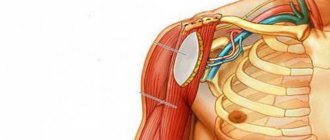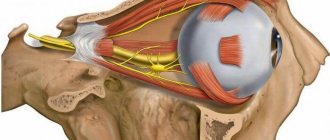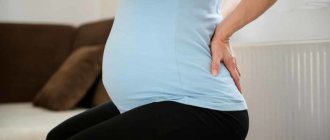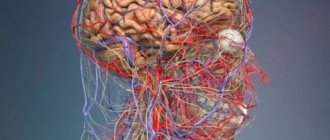Diagnostic measures to identify cerebral palsy during pregnancy
Cerebral palsy can develop while the baby is in the womb. Difficult early diagnosis makes it even more dangerous for the child. To try to identify a disease during gestation, it is necessary to use all available diagnostic methods and know what can cause the disease in order to take the necessary measures.
Cerebral palsy: how it manifests itself
It is impossible to detect cerebral palsy in a timely manner while the fetus is pregnant; there is no special diagnosis for this. Early signs of the disease can be seen after the baby is born in the form of physical abnormalities. Such a child has a violation of motor skills. He sits up late, starts walking late, and speaks poorly. Parents may notice a lack of interest in toys and fun with peers in a child with cerebral palsy.
Other early manifestations of cerebral palsy in a child:
- Preservation of newborn reflexes for up to six months. There is a group of unconditioned reflexes that is characteristic only of children under two months. For example, if you put a child on his legs and tilt him forward, he will begin to step with his feet forward, or when you press on your palm, his mouth will open. Such reflexes should normally disappear after the second month, but in children with cerebral palsy they remain for some time.
- Impaired vision and eye movement. The patient may experience strabismus, later astigmatism or myopia.
- Lack of healthy interest in learning new information, lack of initiative, coldness towards parents.
- Involuntary movements, chaotic waving of arms, freezing for a long time in one position.
All this can be observed by parents if they suspect cerebral palsy. Only a specialist can make a diagnosis and prescribe supportive therapy. This is a very serious disease due to damage to the central nervous system. The main reasons may be hidden in the prenatal period of a child’s life or in the first months of life.
What is cerebral palsy in newborns?
Cerebral palsy in a newborn child is a dangerous pathology that can be caused in utero by more than 400 factors. They can affect the baby, both during pregnancy and during childbirth or 4 weeks from its moment. The main reason for the formation of cerebral palsy is abnormal changes in the structures of the brain, and the manifestations of the disease occur through various disorders in the motor sphere. The disease hardly progresses; the extent to which the musculoskeletal system is damaged is limited to when cerebral palsy was identified and treatment began.
Most often, a newborn immediately has all the prerequisites indicating the formation of cerebral palsy, and a timely examination facilitates future therapy, preventing an advanced form.
Types
In medicine, there are 7 types of cerebral palsy:
- Hyperkinetic paralysis, when muscle tone remains inconsistent, movements are sweeping and involuntary.
- Atonic-astatic paralysis, in which muscle tone is reduced and makes it difficult to maintain an upright posture.
- Attack paralysis, where coordination of all movements is observed, the baby cannot maintain balance.
- Spastic-hyperkinetic paralysis, when there is a violation of muscle tone, when not only paralysis is present, but also paresis.
- Spastic diplegia, which is characterized by impaired tone of the lower extremities, and the upper extremities are fully or partially functional.
- Spastic tetraparesis, manifested in the form of an almost complete lack of muscle tone and the child’s ability to move.
- Right-sided hemiparesis, when muscle hypertonicity, paresis and the development of contractures develop only on one side of the body.
The division of cerebral palsy by severity is arbitrary; it is related to how damaged the brain is and what awaits the child in the future. So, with a mild form - children in the future are quite independent and can lead normal life activities; moderate severity - the baby will need some help all his life, but will be able to adapt in society, and with a severe form - the baby is forever dependent on his parents and others.
Causes
During pregnancy, etiological factors for the development of cerebral palsy in a baby may be:
- Prematurity. Having a baby prematurely comes with many risks. Paralysis in such children occurs in almost 50% of all cases. This is due to underdeveloped organs, which increases the risk of hypoxia, which is directly related to brain damage.
- Genetics. Some experts suggest that the leading role in the appearance of cerebral palsy in a newborn is played by the hereditary material received from the parents.
- Hemolytic disease. Due to Rh conflict or the presence of liver failure in the fetus, the brain is poisoned by toxins while still in the womb.
- Severe gestation. Severe toxicosis, disturbances of fetoplacental blood flow and similar pathologies during gestation often lead to fetal hypoxia, which affects the development of all organs and systems of its body.
- Diseases of the expectant mother. Any infectious (especially viral etiology) or non-infectious disease in the mother, whether acute or chronic, leads to toxic poisoning of the baby and affects the formation of his brain.
An important role in the pathology of a newborn is played by the lifestyle the expectant mother leads. With frequent stress, nervous tension, abuse of alcohol or certain drugs, the risk of cerebral palsy in the baby increases significantly.
Symptoms for different forms of cerebral palsy
Manifestations of the disease depend on the clinical form. Among them are:
- Spastic diplegia. This form is the most common. The main symptoms include the formation of partial or complete paralysis on all limbs with increased tone. Children do not speak due to hypertonicity in the tongue. Congenital motor reflexes are completely absent, while the severity of tendon reflexes, spontaneous and convulsive movements increases. Attempts to place children in a vertical position are usually unsuccessful, which is associated with disturbances in the position of the feet, motor activity in the joints, and extension and crossing of the legs.
- Hemiparetic form. Its development may be associated with birth trauma. The main manifestations include the formation of spastic hemiparesis with increased tone and tendon reflexes on one side. The arms are affected more than the lower extremities. Gradually, the arms shorten and become thinner. Curvature of the feet and the formation of contractures are manifested by a disturbance in gait with circular movements. The appearance of epileptic seizures is characteristic.
- Hyperkinetic form. The disease develops against the background of Rh-conflict and liver diseases, which are accompanied by an increase in bilirubin levels. It is characterized by the appearance of hyperkinesis, involuntary movements of the limbs and changes in body position. On examination, symptoms of chorea, athetosis, slow convulsions and pathological tendon reflexes are revealed. From time to time, parents complain of increased body temperature, the development of panic fears and heart failure in children, which may be associated with nervous strain. Speech becomes slurred and unintelligible. Changes in hearing are accompanied by sensorineural hearing loss.
- Atonic-astatic form. This form is characterized by a decrease in muscle tone with impaired coordination of movements and the appearance of tremor. Balance is gradually disturbed, which can be caused by an increase in the range of motion in the joints with possible dislocation.
- Double hemiplegia. The signs of cerebral palsy in this case are the most pronounced, which is manifested by severe tetraparesis, severe and gross motor impairment, as well as enhanced tendon and tonic reflexes. Characterized by severe mental retardation with the absence or underdevelopment of speech.
Diagnosis of cerebral palsy in utero
Diagnostic measures during pregnancy, if there are prerequisites for the development of cerebral palsy in the fetus, are aimed at examining its brain, assessing the formation of its structures and functioning.
Is it visible on ultrasound: is it possible to detect
An ultrasound study is informative, but only if the changes in the brain have become quite extensive. The first minor changes in structures will not be detected.
Cardiotocography, non-stress test: how to identify
The non-stress test is a non-invasive diagnostic method. For him, the pregnant woman lies on her left side, with a cushion placed under her back, and the specialist fixes two sensors on her stomach, which are needed to record the frequency of fetal heart contractions and uterine contractions. The duration of the procedure is 20-60 minutes. Based on the data obtained, conclusions are drawn regarding the presence of a hypoxic condition in the fetus, which predisposes to cerebral palsy.
Detection using Doppler, electrocardiography
Doppler measurements, that is, a study of the functioning and structure of the vascular bed and blood flow through the system of the mother, placenta and fetus, as well as electrocardiography show exclusively changes in the form of hypoxia, a factor leading to cerebral palsy, and not the pathology itself.
Biochemical blood markers
The study of biochemical markers in the blood of the expectant mother allows us to assume possible deviations in the development of the fetus, including cerebral palsy, solely on the basis of an increased or decreased number of these indicators. Screening is carried out in two stages:
- Study of pregnancy-associated plasma protein-A and human chorionic gonadotropin.
- Determination of concentrations of human chorionic gonadotropin, alpha-fetoprotein and estriol.
The main causes of occurrence in newborns
There are many factors influencing the occurrence of cerebral palsy in a newborn. In most cases, this disease is diagnosed in children with pathologies of intrauterine development, that is, the cause of the disease is disturbances during pregnancy.
Causes:
- Oxygen starvation of the fetus.
- Damage to the fetal nervous system as a result of viruses transmitted by the mother.
- Rhesus conflict between mother and fetus.
- Hereditary factor and chromosome mutations.
- Asphyxia of the child during childbirth.
- Birth injuries.
- Infections that affect an infant in the first days of life.
- Severe poisoning of a child with toxic substances or drugs.
Children born prematurely are especially susceptible to cerebral palsy. If the mother’s pregnancy was normal and without pathologies, and the baby, for some reason, was born ahead of schedule, he may become ill with this dangerous disease.
During pregnancy
Every pregnant woman should visit her gynecologist regularly. Sometimes the expectant mother feels normal, but the child develops incorrectly. Placental insufficiency can lead to oxygen starvation of the fetus, and this can lead to cerebral palsy in a newborn baby.
When planning a pregnancy, the expectant mother must undergo a thorough medical examination to identify diseases that occur in a latent form, they can negatively affect the unborn child.
Some diseases, such as toxoplasmosis, rubella and others, that affect a pregnant woman can adversely affect the fetus. Severe Rh conflict between mother and fetus is another reason for identifying cerebral palsy in an unborn baby.
Whether cerebral palsy is inherited is a rather controversial issue, however, statistics claim that in a family in which there were cases of this disease, the risk of having a child with this diagnosis is 7% higher.
Typically, cerebral palsy occurs as a result of developmental disorders of the fetus during pregnancy, and less often during childbirth. Scientists are still arguing whether hereditary transmission of this dangerous disease is possible, but statistical data indicate that it is possible. It is impossible to predict the occurrence of cerebral palsy in advance.
Recent research by doctors has shown that there is a genetic component to cerebral palsy. The evidence base for this statement was the cases when such a disease is detected in close relatives.
How effective is pathology detection?
The development of medicine makes it possible to determine the differences in pathologies in the fetus that develop during pregnancy. But cerebral palsy remains a little-studied disease, around which there is much debate and various theories are being built. Existing diagnostic methods do not provide a one hundred percent guarantee that the newborn will be healthy. But they make it possible to make every effort to protect yourself from such a situation and determine the presence of pathology if the research carried out gives results.
The complex diagnostics carried out allows future parents to protect themselves as much as possible from the birth of a newborn with cerebral palsy, but does not provide a one hundred percent guarantee that the pathology will be identified during pregnancy. The correct approach to planning and caution during gestation significantly reduce the risk of such serious pathologies.
Diagnosis during pregnancy
Unfortunately, diagnosing cerebral palsy during pregnancy is impossible. Even after the baby is born, it is not always possible to determine the presence of the disease; most patients are diagnosed in the second half of life.
Cerebral palsy can also develop in a healthy newborn due to injury during or after childbirth, as a result of careless treatment by medical staff or the mother. The baby's brain is very sensitive to physical and chemical damage, oxygen starvation.
It is possible to eliminate the causes of the disease after carrying out the following diagnostic measures:
- ultrasound examination, auscultation;
- cardiotocography, non-stress test;
- Doppler, electrocardiography.
A comprehensive diagnosis of a woman does not guarantee 100% exclusion of the disease. And even a newborn examination cannot confirm the diagnosis. It is necessary to begin examining the child when the first alarming symptoms appear.
If cerebral palsy is suspected, the following diagnostics are performed.
- Computed tomography and nuclear magnetic resonance: the most informative measures to date for brain research. Radiation diagnostics allows you to see any part of the body and obtain a two-dimensional image. CT and NMR make it possible to see brain defects, clarifying the clinical picture of the disease.
- Echoencephalography is an ultrasound diagnostic technique that allows you to identify cerebral palsy from an early age. The study shows the expansion of the ventricles of the brain and the asymmetry of its hemispheres.
- Electromyography is a method for studying the electrical activity of muscle tissue. Unfortunately, this method is not so informative, but it is mandatory for diagnosing cerebral palsy in older children.
- Neurosonography is a method that allows you to clarify the structure and anomalies of the brain, the size of the ventricles and hemispheres.
Confirming the diagnosis requires preparing parents for raising a child with cerebral palsy. Such patients differ from their peers in terms of behavior, but intellectual abilities are preserved in 60% of all children.
Diagnosis of cerebral palsy during pregnancy is not accurate enough. It is impossible to diagnose the presence of cerebral palsy during pregnancy. The main changes at the intrauterine stage occur only in the child’s nervous system and do not in any way affect his physical condition. Therefore, ultrasound examination, tests, screenings are powerless to detect deviations from the norm.
The problem is also complicated by the fact that the condition can begin to develop at any stage of gestation. Most often it is caused by pathological childbirth, even if the child was initially healthy at the stage of intrauterine development. It is impossible to diagnose cerebral palsy, but the factors that provoke its occurrence can not only be diagnosed, but also eliminated.
Sources











